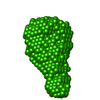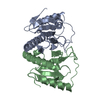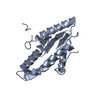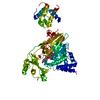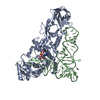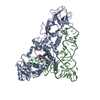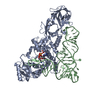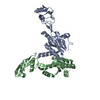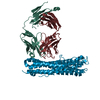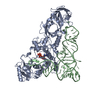[English] 日本語
 Yorodumi
Yorodumi- SASDCK6: Sheath tail protein (DSY3957) from Desulfitobacterium hafniense, ... -
+ Open data
Open data
- Basic information
Basic information
| Entry | Database: SASBDB / ID: SASDCK6 |
|---|---|
 Sample Sample | Sheath tail protein (DSY3957) from Desulfitobacterium hafniense, Northeast Structural Genomics Consortium Target DhR18
|
| Function / homology | : / Tail sheath protein Gp18 domain III N-terminal region / Phage tail sheath protein, beta-sandwich domain / Phage tail sheath protein beta-sandwich domain / Tail sheath protein, subtilisin-like domain / Phage tail sheath protein subtilisin-like domain / Tail sheath protein, C-terminal domain / Phage tail sheath C-terminal domain / Phage tail sheath protein Function and homology information Function and homology information |
| Biological species |  Desulfitobacterium hafniense (strain Y51) (bacteria) Desulfitobacterium hafniense (strain Y51) (bacteria) |
 Citation Citation |  Journal: Biopolymers / Year: 2011 Journal: Biopolymers / Year: 2011Title: Small angle X-ray scattering as a complementary tool for high-throughput structural studies. Authors: Thomas D Grant / Joseph R Luft / Jennifer R Wolfley / Hiro Tsuruta / Anne Martel / Gaetano T Montelione / Edward H Snell /  Abstract: Structural crystallography and nuclear magnetic resonance (NMR) spectroscopy are the predominant techniques for understanding the biological world on a molecular level. Crystallography is constrained ...Structural crystallography and nuclear magnetic resonance (NMR) spectroscopy are the predominant techniques for understanding the biological world on a molecular level. Crystallography is constrained by the ability to form a crystal that diffracts well and NMR is constrained to smaller proteins. Although powerful techniques, they leave many soluble, purified structurally uncharacterized protein samples. Small angle X-ray scattering (SAXS) is a solution technique that provides data on the size and multiple conformations of a sample, and can be used to reconstruct a low-resolution molecular envelope of a macromolecule. In this study, SAXS has been used in a high-throughput manner on a subset of 28 proteins, where structural information is available from crystallographic and/or NMR techniques. These crystallographic and NMR structures were used to validate the accuracy of molecular envelopes reconstructed from SAXS data on a statistical level, to compare and highlight complementary structural information that SAXS provides, and to leverage biological information derived by crystallographers and spectroscopists from their structures. All the ab initio molecular envelopes calculated from the SAXS data agree well with the available structural information. SAXS is a powerful albeit low-resolution technique that can provide additional structural information in a high-throughput and complementary manner to improve the functional interpretation of high-resolution structures. |
- Structure visualization
Structure visualization
| Structure viewer | Molecule:  Molmil Molmil Jmol/JSmol Jmol/JSmol |
|---|
- Downloads & links
Downloads & links
-Models
| Model #1439 |  Type: atomic / Radius of dummy atoms: 1.90 A / Chi-square value: 1.943236  Search similar-shape structures of this assembly by Omokage search (details) Search similar-shape structures of this assembly by Omokage search (details) |
|---|---|
| Model #1440 |  Type: dummy / Radius of dummy atoms: 2.50 A / Chi-square value: 1.890625  Search similar-shape structures of this assembly by Omokage search (details) Search similar-shape structures of this assembly by Omokage search (details) |
- Sample
Sample
 Sample Sample | Name: Sheath tail protein (DSY3957) from Desulfitobacterium hafniense, Northeast Structural Genomics Consortium Target DhR18 Specimen concentration: 1.66-5.26 |
|---|---|
| Buffer | Name: 5 mM DTT 100 mM NaCl 10 mM Tris-HCl 0.02 % NaN3 / pH: 7.5 |
| Entity #754 | Type: protein / Description: Uncharacterized protein / Formula weight: 48.285 / Num. of mol.: 1 / Source: Desulfitobacterium hafniense (strain Y51) / References: UniProt: Q24QE6 Sequence: MAAGTFTAQN KVRPGVYINF KSEPQAAGTL GERGIVSMPL ILSWGEPGKM ITIEAGDDVF PKLGYSIMDA QLRLINEALK RAKTLLLYRL NAGTKAAVTV GNLTVTAKWG GARGNDITLV IQENIDDETK FDVSTLVDGA ELDKQTVSDI AGLAANDWVI FSGTGALTET ...Sequence: MAAGTFTAQN KVRPGVYINF KSEPQAAGTL GERGIVSMPL ILSWGEPGKM ITIEAGDDVF PKLGYSIMDA QLRLINEALK RAKTLLLYRL NAGTKAAVTV GNLTVTAKWG GARGNDITLV IQENIDDETK FDVSTLVDGA ELDKQTVSDI AGLAANDWVI FSGTGALTET AGAPLINGSD GAVTNQAYID YLAAVEIFDF NTIALPSTDD ALKATFTAFA KRLRDDEGKK IQVVLENYPA ADYEGVISVK NGVVLADGTI LTAAQATAWV AGATAGARVN ESLTYQGYDE AVDVAPRYTN AQIIAALQAG EFLFTASDNQ ALVEQDINTL TSFTADKGKQ FAKNRVIRVL DGINNDFVRI FSKFYIGKVS NNADGRNLLK SECINYMNTL QDIDAIKNFD GQTDLTVQSG NDVDAVYIEA YAWPVDSIEK IYVRVRIKLE HHHHHH |
-Experimental information
| Beam | Instrument name: Stanford Synchrotron Radiation Lightsource (SSRL) BL4-2 City: Stanford, CA / 国: USA  / Type of source: X-ray synchrotron / Wavelength: 0.13 Å / Dist. spec. to detc.: 1.5 mm / Type of source: X-ray synchrotron / Wavelength: 0.13 Å / Dist. spec. to detc.: 1.5 mm | ||||||||||||||||||
|---|---|---|---|---|---|---|---|---|---|---|---|---|---|---|---|---|---|---|---|
| Detector | Name: Rayonix MX225-HE | ||||||||||||||||||
| Scan | Measurement date: Feb 12, 2010 / Storage temperature: -80 °C / Cell temperature: 20 °C / Exposure time: 1 sec. / Number of frames: 20 / Unit: 1/A /
| ||||||||||||||||||
| Distance distribution function P(R) |
| ||||||||||||||||||
| Result |
|
 Movie
Movie Controller
Controller

 SASDCK6
SASDCK6
